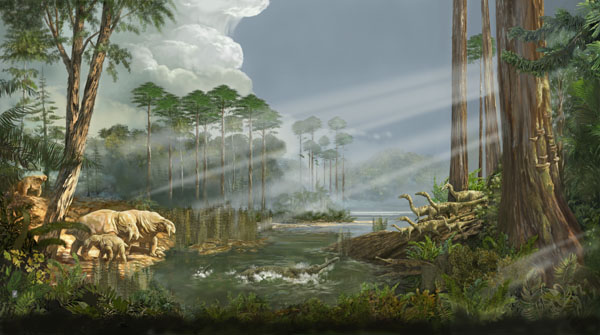 |
 |
 |
 |
 |
Produced
by the Population Genetics and Evolution class, Furman University |
||||
 |
 |
 |
 |
 |
Produced
by the Population Genetics and Evolution class, Furman University |
||||
 |
The
Triassic |
 |
||
 |
The Triassic Period followed the greatest mass extinction event in Earth's history, and the few surviving lineages like lycopods, seed plants (Glossopteris and conifers), and synapsids dominated early. Temnospondyl amphibians like Mastodonsaurus were still present, and there were some surviving synapsid lineages such as the predatory cynodont, Cynognathus, and the herbivorous dicynodont, Kannemeyeria. But the mid-triassic "Triassic turnover" saw diapsid reptiles come to dominate most animal niches. Three great clades evolved. Two would dominate the seas, initially: the Lepidosaurs (like Triassic placodonts and their Jurassic descendants the pliosaurs and plesiosaurs) and the Ichthyosaurs. The third, the Archosaurs, would dominate the land and air. The Archosauria includes two groups: the Crucrotarsi (crocodiles and their kin, like the Triassic Phytosaurs and Ornithosuchans) and the Ornithodira (pterosaurs, dinosaurs, and their descendants, the birds). Crucrotarsans and pterosaurs were abundant throughout the Triassic, but true dinosaurs, like Eoraptor, would not evolve until the late Triassic. Also, an anapsid lineage was radiating; represented by Odontochelys and the ancestral lineage of testudines (turtles and tortoises). So, in the oceans, land, and air, early radiations of diapsid reptiles filled ecological niches. Synapsid lineages declined, limited to the dicynodont herbivores that would last through the Mesozoic, and the earliest mammaliform lineages that were also evolving in the late Triassic. |
 |
||
| Above: a Pterosaur fossil; Photo From: Wikimedia Commons Below, a dicynodont, from: Burnetia | Above: a phytosaur from: The National Park Service Below: Triassic scene, from: Prehistoric Illustrated. |
|||
 |
 |
|||